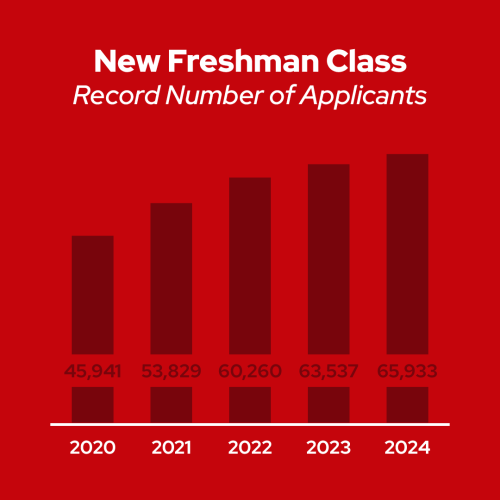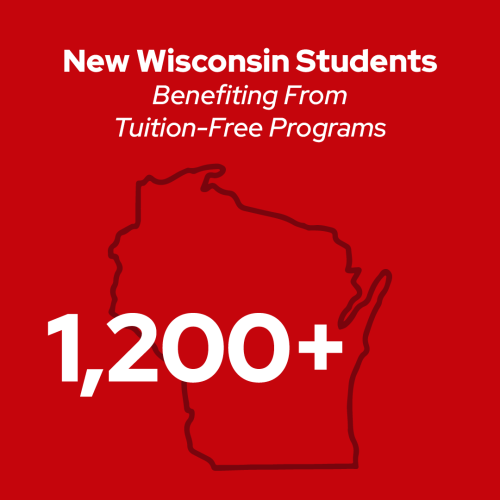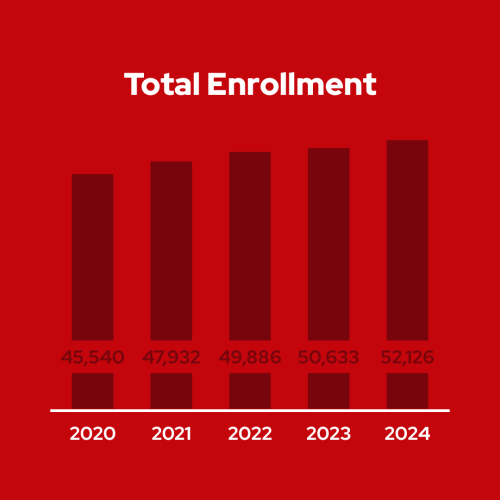The UW–Madison campus. Photograph: Jeff Miller
The College of Wisconsin–Madison stays a prime vacation spot for gifted college students from the state, the nation and the world, with a record-setting 65,933 candidates for this 12 months’s fall freshman class. The college enrolled 8,516 freshmen, its second-largest freshman class. It additionally welcomed 1,375 new switch college students to campus this fall.
“We’re thrilled that these distinctive college students have chosen UW–Madison as their higher-education dwelling,” says Chancellor Jennifer L. Mnookin. “In return, we decide to offering them with what has been this college’s hallmark for 175 years — a world-class schooling that prepares college students to tackle society’s hardest challenges and change into transformative leaders of their professions and their communities.”
“We’re additionally proud,” Mnookin provides, “to welcome so many college students from Wisconsin and to have the ability to take away monetary limitations for many who might not in any other case have the ability to attend UW–Madison.”
Greater than 1,200 freshmen and new switch college students from Wisconsin can have their full tuition — and infrequently way more — lined by one of many college’s monetary help initiatives for home-state Badgers.
Expanded outreach and recruiting
New recruiting and outreach efforts by the college embrace the School for Rural Wisconsin, which works to extend faculty entry for rural, farm and small-town college students in Wisconsin, and a devoted regional and worldwide recruiting workforce with members based mostly in six areas throughout the nation and outreach efforts across the globe. The college additionally launched the Wisconsin Tribal Academic Promise Program.
“Via our elevated recruiting efforts and our holistic utility evaluation course of, we are going to proceed to seek out exceptional Badgers who’re poised to seek out success at UW–Madison and contribute to our vibrant group,” says Derek Kindle, vice provost for enrollment administration.
 Allison Wagner, founding govt director of All-In Milwaukee, a better schooling nonprofit, says UW–Madison has been a terrific companion in supporting distinctive college students from various, low-income neighborhoods in Milwaukee. Now in its seventh 12 months, All-In Milwaukee has its largest cohort of Badger freshmen this fall at 52, for a complete of 145 college students affiliated with the group at present on campus. Most are first-generation faculty college students.
Allison Wagner, founding govt director of All-In Milwaukee, a better schooling nonprofit, says UW–Madison has been a terrific companion in supporting distinctive college students from various, low-income neighborhoods in Milwaukee. Now in its seventh 12 months, All-In Milwaukee has its largest cohort of Badger freshmen this fall at 52, for a complete of 145 college students affiliated with the group at present on campus. Most are first-generation faculty college students.
“UW–Madison works with us to recruit various college students after which helps construct a real group for them on campus,” says Wagner, a UW–Madison alumna. “From my perspective, I see a deep dedication on the a part of the college’s management to creating positive that extra college students from Milwaukee can make the most of Wisconsin’s flagship public college and succeed as soon as they’re there.”
Race and ethnicity
This 12 months’s freshman class is the primary because the U.S. Supreme Courtroom dominated that an applicant’s race may not be thought-about in faculty admissions selections. UW–Madison had beforehand thought-about race as certainly one of many components in a holistic admissions course of that centered before everything on a candidate’s tutorial energy.
As predicted by outcomes at universities that have been prohibited from utilizing race within the admissions course of earlier than UW–Madison, the Supreme Courtroom choice impacted the racial and ethnic make-up of the incoming class.
The share of underrepresented college students of coloration within the freshman class dropped by 3.7 proportion factors (to 14.3% this 12 months from 18% final 12 months). The class contains home college students who establish as African American/Black, Vietnamese, Hmong, Laotian, Cambodian, Hispanic/Latino(a), Native Hawaiian/Pacific Islander, or American Indian/Alaska Native. The racial demographics of worldwide college students are usually not included in these totals. Previous to this 12 months, the proportion of underrepresented college students of coloration within the freshman class had constantly elevated for a number of years, peaking final 12 months at 18%.
The share of scholars of coloration within the freshman class dropped by 3.2 proportion factors (to 27.3% this 12 months from 30.5% final 12 months). The class contains all of the home college students within the underrepresented group plus different home college students who establish as Asian.
“Although declines are disappointing, I wish to be clear that our dedication to those college students and their communities stays steadfast,” Mnookin says. “We’re totally dedicated to additional efforts to construct a campus group that welcomes individuals from all identities, lived experiences, views and beliefs, and to do that work in ways in which adjust to the legislation and align with our mission and our values.”
Tribal initiative
That is the primary tutorial 12 months for the Wisconsin Tribal Academic Promise Program, introduced by Chancellor Mnookin final December. It provides monetary assist to cowl the complete price of pursuing an undergraduate diploma for Wisconsin residents who’re enrolled members of federally acknowledged Wisconsin Indian tribes. The dedication covers not solely tuition and charges but in addition housing, meals, books and different instructional bills.
“Once I first heard about it, I bear in mind pondering it was so good that it was taking place as a result of plenty of Native children can’t afford to go to varsity and funds are usually a little bit of a problem,” says Juno O’Connor, a freshman from Solar Prairie, Wisconsin, and an enrolled member of the Crimson Cliff Band of Lake Superior Chippewa. “I believe it is going to imply that extra Native children will have the ability to go to varsity.”
O’Connor, a historical past main who excelled in Educational Decathlon competitions in highschool, is certainly one of 22 freshmen receiving the Wisconsin Tribal Academic Promise. 9 new switch college students and 42 persevering with undergraduates are also lined by the initiative, for a complete of 73 undergraduates within the inaugural 12 months.
Wisconsin focus
The tribal initiative joins Bucky’s Tuition Promise and Bucky’s Pell Pathway in making an schooling on the state’s flagship public college extra inexpensive for Wisconsin residents. Bucky’s Tuition Promise covers tuition and segregated charges for college kids whose family adjusted gross earnings is $65,000 or much less. Bucky’s Pell Pathway commits to assembly full monetary want with out loans for Badgers from low-income Wisconsin households.
 This fall, there are greater than 1,200 freshmen and new switch college students lined by the three initiatives — one in 4 Wisconsin resident college students new to campus. Bucky’s Tuition Promise has helped greater than 6,500 college students attend UW–Madison since its inception in 2018. Bucky’s Pell Pathway, in its second 12 months, has to date been awarded to about 3,750 college students.
This fall, there are greater than 1,200 freshmen and new switch college students lined by the three initiatives — one in 4 Wisconsin resident college students new to campus. Bucky’s Tuition Promise has helped greater than 6,500 college students attend UW–Madison since its inception in 2018. Bucky’s Pell Pathway, in its second 12 months, has to date been awarded to about 3,750 college students.
Hayden Leonard, a freshman pc engineering main from Watertown, Wisconsin, is amongst this 12 months’s recipients of Bucky’s Pell Pathway. At Watertown Excessive Faculty, Leonard was president of the SkillsUSA chapter, a workforce growth pupil group. He certified for nationwide competitions all 4 years and received gold as a part of a workforce. Leonard stated he had been torn between UW–Madison and one other prime engineering college till UW–Madison’s superior monetary help provide got here by way of.
“I couldn’t consider it,” Leonard says of Bucky’s Pell Pathway. “It was the deciding issue. It’s superb to not have to fret about funds.”
UW–Madison is as soon as once more exceeding its dedication to enroll a minimal of three,600 new Wisconsin resident freshmen. This 12 months’s determine of three,825 is particularly important given the stagnant variety of Wisconsin highschool graduates and the lowering variety of Wisconsin highschool graduates pursuing post-secondary schooling.
A separate Board of Regents enrollment coverage measures UW–Madison’s dedication to the state by requiring the college to enroll yearly at the least 5,200 new undergraduate college students (new freshmen and new transfers) who’re Wisconsin residents or Minnesota reciprocity college students based mostly on a three-year rolling common. The college exceeds this with its most up-to-date common of 5,616.
By the numbers
 Complete enrollment: A file 52,126 college students, up 2.9% from 50,633 final 12 months.
Complete enrollment: A file 52,126 college students, up 2.9% from 50,633 final 12 months.
- Freshman candidates: A file 65,933, up 3.8% from 63,537 final 12 months.
- Freshman class enrollment: 8,516, up 6.9%, from 7,966 college students final 12 months.
- Freshman class by race/ethnicity: The share of Black college students enrolled dropped to 2.1% from 3% final 12 months; Hispanic/Latino(a) enrollment dropped to eight.5% from 10%; Asian enrollment dropped to 11.8% from 12%, although the variety of Asian freshmen rose; “two or extra races” enrollment dropped to 4.7% from 5.2%; white enrollment elevated to 60.4% from 58%. The share of freshmen who declined to offer their race rose to 4.2% from 3.2%.
- The variety of college students figuring out solely as American Indian/Alaska Native college students within the freshman class decreased from 22 final 12 months to 13 this 12 months. (Observe: Many Native college students establish as multiple race.)
- New switch college students: 1,375, up 21.8% from 1,129 final 12 months.
- Greater than 750 freshmen and new switch college students are recipients of Bucky’s Tuition Promise this fall. About 1,150 are recipients of Bucky’s Pell Pathway, and 31 are recipients of the Wisconsin Tribal Academic Promise Program. (Observe: Some college students qualify for multiple program, so there’s some overlap within the numbers.)
- The share of scholars within the freshman class who’re eligible for federal Pell grants, a major driver in entry to greater schooling for lower-income college students, rose to twenty.9% from 16.7% final 12 months.






























































